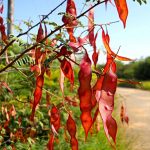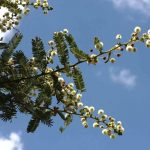TREE LIFE
April 1987
MASHONALAND CALENDAR
Tuesday April 7th : Botanic Garden walk. Meet in the Car Park at 1645 for 1700 hours
Saturday April 11th : Mukuvisi Woodlands Key : This is yet another opportunity for you to help us improve the leaf key to trees and shrubs of the Woodland. Those who have already attended will agree that this exercise is both enjoyable and informative. We would welcome newcomers and beginners particularly, but will be happy to see as many as possible. Meet at Meg’s house, 12 Kariba Crescent, at 1500 hours.
Sunday April 12th : Woodlands Farm, Shamva. We are hoping to find the Cordia in full flower, in which case this should be a memorable visit. Besides that its an excellent venue as the drop in altitude and change in rainfall introduces a number of species we seldom see. Please note this is the second Sunday and not the third. A bus has been booked to leave from Monomatapa Car Park at 0815 hours. A security guard will look after the cars. Fare $14.
MATABELELAND CALENDAR
Sunday April 5th : We will go to Mubukuweni. Meet there at 0830 hours.
On Sunday March 1st well guided as usual by the Archers, we went to the Matopos mainly to the Cat’s Cradle area, which lies more or less below the Shangani Memorial.
We identified some 80 trees in a very pleasant outing. Though hot there was a cool breeze and wonderful views when we climbed. There were no Acacia in the area, though we did see Acacia rehmanniana when we moved on.Of note were Afzelia quanzensis, pod Mahogany, both Brown and Green Paper barks, Albizia tanganyicensis, Commipora marlothii, some very tall Aloe excelsa
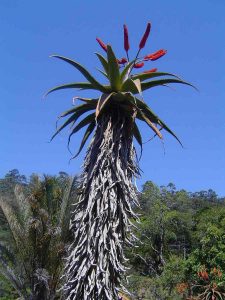
Aloe excelsa. Photo: Bart Wursten. Source: Flora of Zimbabwe.
lot of powdery white Brachylaena rotundata, which seems misnamed, as the leaves are quite pointed, Bridelia mollis, Burkea africana with leaves already turning brown and yellow, Canthium lactesens, Cassia abbreviata with no long pods showing yet, some very shiny leaved Clerodendrum myricoides, Combretum apiculatum, C.hereroense, C.molle, Elephantorrhyza goetsii, Erythrina latissima, Euclea divinrum, E.natalensis, E.racemosa subsp. schimperi, this last species was very bright and shiny, Euphorbia griseola, Euphorbia ingens, Ficus abutifolia, soldanella, Ficus glumosa, sonderi, Ficus ingens, Grewia flavescens, G.monticola, Heteropyxis dehniae with strong lavender aroma, Baboon’s breakfast, Hexalobus monopetalus, in many clumps, Mundulea sericea still flowering a little, Ochna glauca, Ochna pulchra peeling well, Olea europea subsp. africana, Pavetta eylesii with flaking bark, Pavetta gardenifolia, assimilia, Pavetta schumanniana and around the corner was a magnificent Mobola plum, Parinari curatellifolia, Pittosporum viridiflorum which foxed us a while, some very large Pouzelzia mixta, hypoleuca, some very fine specimens of Pseudolachnostylis, Psydrax livida, Canthium huillense, Rhus leptodictya, Strychnos madagascariensis, Strychnos matopensis, Tarenna neurophylla, T.zimbabwensis, Enterospermum rhodesiacum, Terminalia sericea, Terminalia trichopoda, Tetradenia brevispicata, ginger bush, Turraea obtusifolia, Vepris reflexa, Ximenia caffra, Zanthoxylum capensis, Fagara, Zizyphus mucronata.
C.Sykes
BOTANIC GARDEN WALK, 3RD MARCH 1987
With Tom otherwise occupied, I led the walk around the more smelly party of the garden. The nose is a wonderful tool for identifying plants and many families have distinctive smells. The smells originate from different parts of the plant and we began with the glandular hairs on the legume of Ormocarpum kirkii, and moved on to the ginger leaves of Tetradenia riperia. The stapeliads provided the nose bending stench of rotten meat and a Commiphora illustrated the common aromatic oils present in the berry. We contrasted this with the peppery smell of C.mossambicensis, the only Commiphora species that I can differentiate on smell alone. Steganotaenia araliacea illustrated the carrot like smell of the APIACEAE and Parinari curatellifolia obliged by filling the air with the stench of overflowing sewers. Warburgia salutaria has a peppery taste to the leaves and Hypericum roeperanum smelt of curry, next time we will move along to the small leaved H.revolutum and see if it is stronger. Calodendrum capensis represented the RUTACEAE smell and was also adorned with flowers.
The two lavender smells, Heteropyxis natalensis and Croton gratissimus showed us how different smells seem to engender similar names. Carissa edulis provided the heavily scented flowers that seem to occur on all the APOCYNACEAE and Maytenus undata smell like stale waxproof paper. The Combretum section was really doing its thing with that sickly sweet smell we so often find in the bush the flowers of Terminalia prunoides in smell so sweetly they actually stank and the Acacia nilotica provided the rich smell of green apples. The flowers of A.ataxacantha illustrated that earthy smell of the Acacia genus which is particularly powerful when trees are uprooted or the roots are damaged. For once we were unable to smell the potato creeper, Phyllanthus reticulatum but we do pick that up so often on our late afternoon wanderings. Such a rewarding walk would be impossible without Tom’s dedication; Tom is currently in hospital with a painful spine. We wish him a most speedy recovery and thank him again for the many hours of pleasure which his garden provides us.
-Kim Damstra.
BOTANIC GARDEN EXTENSION, CHRISTON BANK : MARCH 15TH 1987
Trying to use a Tree Society outing as an excuse did not work when trying to avoid the Cycling Club as their 48 km race via Mazowe Orange Kiosk was planned to arrive at Christon Bank in time for the Tree Society. Due to an excellent handicap, earned by a very non professional appearance in bare feet and string vest, I was first across the line and ready for botanizing. The extension covers a number of vegetation types and I was most surprised when members followed Barbara’s brisk pace over the hill and down to the river. The discipline in passing Tapiphyllum, Uapaca nitida and a grove of Zanha africana was most commendable. We began with the downstream riverine vegetation at the bottom of the boundary fence. The altitude is lower than that around Harare and the river provides a natural alley for the growth of a medium altitude community. We were surprised at the lack of Syzygium along this stretch of the river, we may remember discovering Syzygium masukuense below the Mazowe Dam wall.
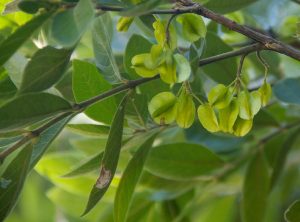
Combretum erythrophyllum. Photo: Bart Wursten. Source: Flora of Zimbabwe.
Tall Combretum erythrophyllum with distanct cat’s claw marks on the trunk and a magnificent Rhus lancea had fallen across the river when their root system had been under mined but both had continued to grow by sending up vertical shoots. The power of the water in this area was well demonstrated when we visited Thetford soon after a cloudburst and when the waterline was well above the riverbank. Although we approached the river from a different angle, Thetford is just opposite and slightly downstream from where we were. Graceful female Ilex mitis were in red berry and a few small trees displayed the holly like serrations along the leaf margin. I still think the deeply grooved mid vein is the most consistent feature. The tall fine leafed trees were probably Albizia amara. The middle storey consisted of a young Strychnos potatorum, small Mimusops zeyheri, bushy Myrica serrata with a golden sheen to the leaf’s under surface, Diospyros lycioides with the females in ripe fruit that is not exactly an offering suitable for the Gods, and Friesodielsia obovata in green fruit.
At waist height Teclea rogersii is a common shrub, its trifoliolate leaves have the pellucid gland dots characteristic of the RUTACEAE, but we found no flowers so were unable to demonstrate the difference between this shrub and Veprix reflexa, seen not in Coates Palgrave. Acokanthera oppositifolia displayed its opposite leaves with poisonous milky sap and ripe purple berries.
Wandering upstream we found a most knobbly trunk almost as though scattered points along the trunk had exploded outwards like popped corn. The tree was Myrica serrata and these explosions are breathing pores called lenticels. Trunks are alive and need to breathe in order to grow, but they also need the protection provided by bark. In woodland trees the thick corky bark is often fissured and cracked so the lenticels are not obvious. But riverine trees often have a smoother bark and so the lenticels are generally more obvious. Each lenticels consists of loosely packed cells, the numerous air spaces in between allow O2 and CO2 to diffuse in and out respectively. Excellent lenticels were also seen on Pittosporum viridiflorum although here they are smaller and more defined.
We still had not found the Chionanthus and so followed the path upstream past a small grove of slender trees 3 to 4 m tall which I mistook for Crotalaria, but Richard Mithen, who is doing post doctoral research into the cowpea genus, VIGNA, pointed out the hairs which are divided into two horns that lie flat against the leaf at 180o to one another. These are characteristic of Indogofera and this pinnate leafed tree was later confirmed as Indogofera lupitana. Passing Acacia polyacantha, Peltophorum africanum and Faurea saligna the path led us into a woodland dominated by Brachystegia spiciformis and Monotes glaber. A little further on we turned down to the river once again to be rewarded by an enormous Olea europea subsp. africana and, just downstream, the sought after Chionanthus battiscombei. Both trees have pale twigs with simple, dark green, opposite decussate leaves. Meg discovered the soft leaves on Erythrococca trichogyne and along the bank we were surprised to find Cassipourea malosana. This belongs to the RHIZOPHORACEAE and is the only other family besides RUBIACEAE to have simple, opposite leaves with interpetiolar stipules. It differs from the RUBIACEAE as the leaves are serrated and not entire.
Tired and hot we began the long trek up the hill to lunch. By now there was little difficulty persuading folks to keep to the path and not go Red Hood Riding into the woodland, although Meg did notice a small Syzygium gerrardii to prove a point. I am sure folks will agree that the trek was worthwhile.
-Kim Damstra
The morning had been a very exciting one, but it had also been very hot and physically trying and when we set off in the afternoon our numbers had dwindled to the “interested tail”.
Those of us who stayed found some interesting trees, some of them rather unexpected. We spotted a Swartzia madagascariensis, Snake Bean, and had a chat about how the pinnate leaves have sub-opposite to alternative leaflets with a single large one at the end, similar to
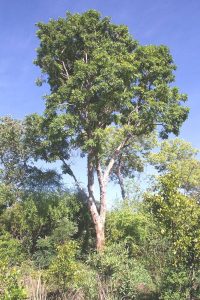
Pericopsis angolensis. Photo: Petra Ballings. Source Flora of Zimbabwe
Pericopsis angolensis, Muwanga. One of the obvious differences being in the bark and so I was delighted to find a Muwanga to demonstrate the difference. The bark of the Snake Bean is dark, very rough and corky compared with the Muwanga with its pale flaky bark. Our specimen being slightly out of it environment was not as typical as it might have been.
We found Uapaca nitida with the growing tip so similar to larger Uapaca kirkiana that there was no doubt about the identification even though the leaves, like the petioles, are long and slender by comparison.
Rhus leptodictya was very variable; in fact I had a certain amount of difficulty convincing everyone that the 3 or 4 different Rhus’s we saw were all the same species. That identification has since been confirmed. There were Hymenodictyon floribundum, the firebush, with the odd leaf starting to tinge with the promise of the magnificent autumn colours to blaze forth shortly.
While we sat and enjoyed the breeze and the view, behind us were two Commiphoras, Commiphora mollis, soft leaved Commiphora and Commiphora marlothii which also has soft leaves, but fortunately has a distinctive paper bark giving it the name Paper bark Commiphora. They also both have compound or pinnate leaves which are imparipinnate, ending in a single leaflet. However the Paper bark Commiphora has 3 to 4 pairs of opposite leaflets which have asymmetric bases and scalloped or toothed margins and are a fresh green colour. The soft leaved Commiphora, aptly named as “mollis” means soft – has up to 6 pairs of smaller leaflets, which are grey green in colour and have a tapering base and an entire margin. The bark does tend to peel, but only in very small pieces, whereas we have written letters to our cousins on the paper of the Paper bark Commiphora albeit using a very soft pencil.
Also on top was a bush with rather russet leaves towards the tip and was obviously the daisy and thistle family. This has proved to be Vernonia kreismannii. We had no difficulty in seeing that it was obviously not V.amyodalina nor V.colorata. Despite referring back to our notes on the visit to Lowdale Farm, just over the hills, when we first encountered V.kreismannii I have been unable to re-establish the differences.
The climax of the day was finding an Ochna – apparently schweinfurthiana with the wrong bark. Hoping it would prove to be O.cyanophylla we plucked some leaves and took them home in great anticipation and slept on them that night. Neither we, nor the leaves, turned black overnight either proving that “we” are not princesses or that the Ochna was not cyanophylla. However, I think the upper surface of the leaves is tinged a bluish green now that they are dry and I propose to watch this tree and try to catch it in flower and/or fruit. Having learned to recognize O.schweinfurthiana by the bark I do not believe that particular tree is the same species.
That is an area close to town and very well worth further investigation.
-Meg Coates Palgrave
BINGA SWAMP FOREST
I took my wife, a couple of friends and a small gang of labourers to Binga on the 15th February. We pulled up quite a considerable number of Mauritius thorn seedlings and cut a number of larger ones that were about to flower. Surprisingly we had to scout around to look for the seedlings. This is an indication, I believe, that we are winning that particular battle. However, the forest is still drying out particularly along the North West corner outside the inner fence, but happily the eastern and southern surrounds are still fairly wet. The stream on the south side is running. Incidentally we cleared a fair amount of the thorn from alongside this stream and from other clumps of trees not in the inner fenced part of the forest.
I don’t think a major effort is required at this time. From time to time a small party of half a dozen or so would be of great help, armed with cutters and cloves. The major problem is the drying out.
-Stan Carey
DIX AIREY
News recently reached the Tree Society of the death in Durban of Dix Airey, an enthusiastic member of the Society and a much liked chairman. To all of us who knew Dix he was a most delightful companion on our trips. By profession a mining engineer he was an interesting informant on whatever geological structure we were on and the vegetation that went with it. His life’s work was in particular his association with the mines of the Great Dyke and he was at one time manager of the Ethel Mine Mutoroshanga. He arranged several trips to mines for us, partly in connection with the modern replanting with grasses and certain trees on the mine dumps to prevent the dry sands from being blown all over the countryside, to its detriment. Dix also made a point of bringing in some younger members to the society.
To his wife Audrey, we extend our deepest sympathy in her loss which we share.
-Gill Masterson
FOOTNOTE : Dr. Colin Craig, Officer in Charge at Sengwa Wildlife Reserch Institute discovered an unusual forest in an area they call the Lost Valley (18o01’S,27o55’E). Six species in particular are of interest, with two of them being new records for Zimbabwe. These species are Cyathea dregei, the common tree fern in the Eastern Highlands but also occurs at Matopos and there are these few on Gletwyn in Harare. This Sengwa population is quite isolated.
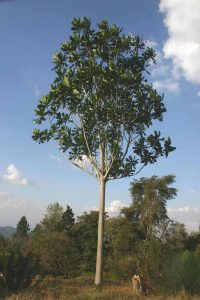
Anthocleista grandiflora. Photo: Bart Wursten. Source: Flora of Zimbabwe.
Anthocleista grandiflora, another species more commonly seen in the Eastern Highlands. Cassipourea gossweilori, previously collected in the Hurungwe. Ochna afzelioides a species previously recorded from Zambia including Katombora. Colin and I headed down to the southern shores of the Sabakwe last week and discovered a number of things. Firstly, he pointed out the largest Pteleopsis anisoptera I have ever seen growing in the centre of Kadoma. A grove of them grows behind the Police Station alongside the government petrol pump, another specimen grows alongside the road as you enter the town from Harare. Just south of the Sebakwe dam we were looking for endemics on the serpentine rock of the Great Dyke. Here we found Acacia chariessa really comes into its own on serpentine soils and grows into a shrub up to 3 to 4 m straggling tree. These specimens were still in flower and covered in the bright red legumes we saw at Falcon College last month. The delicate foliage makes this one of the most attractive Acacia species. Another most attractive species was Rhus tenuipes, the Serpentine Rhus, with very delicate leaflets conspicuously toothed and with a red petiole. All the leaves droop downwards. On the journey homewards, via Umvuma, we spotted many Ormocarpum trichocarpum, only recognized from the road because we saw them at Falcon last month. I thank Colin for this exciting opportunity
-Kim Damstra.
OLIVES AND OLIVE TREES
I have made vague mention of cultivated olives in Zimbabwe but only recently acquired some real information on the subject from Chris Fenton Wells, an enthusiastic farmer we met up with again on our visit to Centenary. Chris is currently trying a few cultivars but it is still too early to comment on their success. However, here are some notes gleaned from “Olive growing in South Africa” published by the Department of Agriculture and Water Supply (Inf.Bull.No.530), 1985, and leaflets on “The Cultivation of Olives in summer rainfall areas” by M. A. Coates of the Horticultural Research Institute, Pretoria, (1974). These notes suggest that Olea europaea is the only member of the OLEACEAE with edible fruit, I would still like to complete the processing of Chionanthus fruit which look just like olives except they have a thicker skin, fruit collected last year was neglected during processing. Tom’s Chionanthus fruit profusely in the Gardens. Old olive trees become ridged as we saw at Christon Bank – someone asked if this was distinctive, yes it occurs as a result of differential cambiam activity and results in corrugated buttressing. The roots are generally shallow and spreading. There are usually two flushes of leaves, one in spring, one in autumn and leaves are kept on for 2 – 3 years before falling in spring. Commercial olive trees grow better on their own root stock rather than grafted onto wild root stock. The root stock of our indigenous Olea europeae subsp. africana appears to have a detrimental effect on fruit quality inducing physiological disorders such as “shot berries”, “split pit” and “soft nose”. Climatically it is most important for the winter temperature to fall to around 12.5oC in July and August in order to stimulate the trees to flower but bud initiation is inhibited if the temperature falls too low and -10oC is dangerous. Then again a rapid temperature rise in spring causes problems and high temperature and dry air, sounds like our usual October, causes the excessive dropping of young fruit. The flowers are wind pollinated with some trees being self compatible and others not.
In the Transvaal Middleveld they have found the cultivar “Mission” to be reasonably successful although fruiting is irregular, good when all the climatic factors come together in one year. The cost of insect control is apparently high.
In growing olives the desirable features are palatability the attractive appearance with a smooth even colour; firm and crisp; good storage qualities. All fresh olives taste bitter due to the glucosides that are removed by soaking in water or treating with lye(1.5% NaOH) and soaking in brine. After a few days the fruit begins to ferment and release gas. When my Chionanthus fruit began fermenting I thought something must have gone wrong, but this is supposed to occur. These bacteria (Lactobacillus) convert the fruit sugar to lactic acid. Covering the fruit with brine prevents oxidation and the growth of unwanted yeasts. Fermentation may continue for 9 months or so. In order to extract the oil the olives are washed, ground to a paste in a hydraulic press and the oil removed. It all looks like much patience and know how.
-Kim Damstra
MYSTREE OF THE MONTH
Travelling out on the Borrowdale Road I was startled by an Acacia immediately before the sign stating “Borrowdale Racecourse”. This is a species I was first introduced to in Bulawayo and have since been surprised to find them within 50km of Harare. It is in pod at present – see if you can identify it!
KIM DAMSTRA CHAIRMAN


